A lifesaving hack for bleeding control after a shark attack or open water traumatic event
In my 18-plus years working as Discovery Channel’s lead dive-rescue paramedic for Shark Week, I finally made my first water rescue during an active shark attack. On May 7, 2021, one new member of the Jackass crew was attacked by multiple Caribbean reef sharks during filming in the Bahamas. The attack left a professional stuntman with both arteries severed, partial amputation of the wrist, and a degloving injury to the hand. I can vividly recall the brightness and the amount of blood that was pulsating through the air as I made the approach for the rescue. The bleeding was obviously arterial; this was no flesh wound. The amount of blood and number of sharks retreating as my rescue watercraft pulled up to the victim left no doubt in my mind that this was a real bite. I had to get the victim out of the water at all costs to prevent another bite, but more importantly so that I could control the bleeding. Luckily I was able to accomplish both tasks with the application of the Sea Bright Tourniquet and the inestimable skills of my safety divers and good friends, legendary underwater cameramen Fo Zayed and Mark Rackley.
Bleeding Cannot Be Controlled in the Water
The standards of modern open water rescue demand that victims be removed from the water quickly so that resuscitation procedures can be performed properly with less risk to the rescuer on dry land. (1) This includes the placement of a tourniquet.(3) Any ocean lifeguard with proper aquatic medical and trauma training can understand why bleeding cannot be properly controlled in the water. For starters, clots cannot form in the water, nor can a rescuer evaluate the efficacy of bleeding control procedures if the limb is submerged. Indeed, there are no medical procedures that should be attempted in the water during a critical rescue where the safety of the victim and rescuer is still in question. There are no medical procedures that have proven their efficacy without presenting major risk to the rescuer, including the risk from infectious disease from mouth to mouth/mask ventilations. In cases of active bleeding, the proper application of commercially available tourniquets in the water is near impossible; I have witnessed several unsuccessful attempts by professional shark divers and career ocean lifeguards to properly position and tighten a tourniquet in the open water. Additionally, one cannot properly assess the efficacy of bleeding control measures in the water, even with a mask or goggles on. The residual blood loss from the capillaries will continue to seep even with the best tourniquet. The goal should be to remove the victim quickly so the procedure can be performed properly and assessed as effective.
RELATED FIRE EMS TRAINING
- Stop the Bleeding: Basic Hemorrhage Control
- When and How to Use a Tourniquet
- Training Minutes: Self-Application of Tourniquet
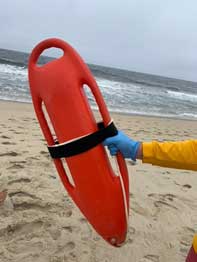
An Unlikely Medical Device
There’s one constant in open water rescue procedures and surf rescue operations under the United States Lifesaving Association’s open water lifesaving standards and National Fire Protection Standard 1006, Standard for Technical Rescue Personnel Professional Qualifications.(1) Most standard rescue procedures call for the use of a rescue floatation device (RFD) during open water operations. It could be safe to say that any technician effecting a rescue for a catastrophic injury in the water will have an RFD in-hand, and this device can then be turned into a tourniquet if the need arises. Any tourniquet created with single nylon strap can be effective at controlling bleeding.(2) The RFD, more specifically its shoulder harness or belt, can be turned into a highly effective circumferential windless tourniquet without any additional equipment using a simple twisting technique that any rescue tech can perform in seconds.
How to Make a Tourniquet from an RFD Harness
More of a technique than a device, the Sea Bright Tourniquet provides effective rapid arterial tamponade in a limb. It’s simple and very quick to apply, and one size fits all. Most types of RFDs on the market use a nylon shoulder harness attached to the device with six to nine feet of nylon line. The brand makes no difference when creating the Sea Bright Tourniquet. On a dive operation, if there are no traditional RFDs available, scuba weight belts can be stripped of their lead and turned into a version of the Sea Bright tourniquet instantly. The Sea Bright tourniquet controlled the vast majority of bleeding the aforementioned attack within 10 seconds of application, giving us time to place a medical grade tourniquet once my backup med-gear was on deck. Please see the step-by-step procedure below.
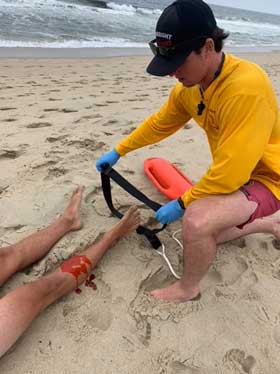
(2) Place harness around extremity high and tight. Photo Lt. Dan Maloney SBOR 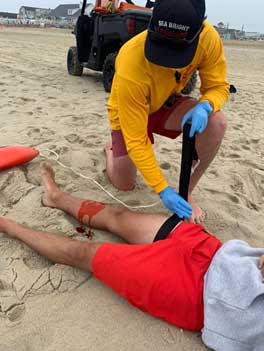

(3) Grasp a handful of the harness and continue to twist over and over again, increasing equal circumferential pressure. Photo Lt. Dan Maloney SBOR 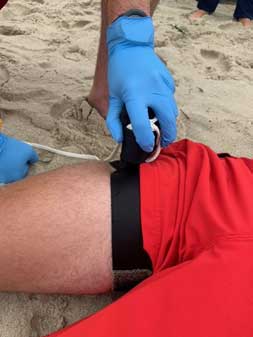
(4) Twist the harness until bleeding stops. DO NOT let go of the harness until a commercial tourniquet is placed. 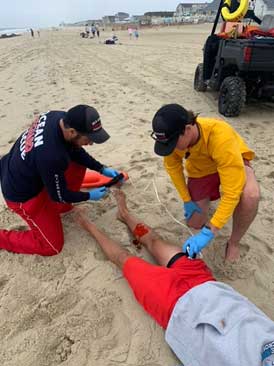
(5) Place a commercial tourniquet proximal to the harness and tighten until the remainder of the bleeding is obliterated. 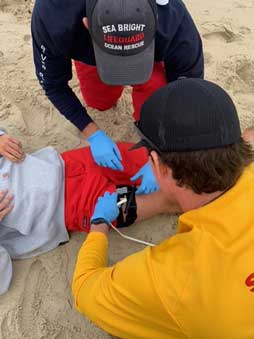
See attached Shark Attack Skills Sheet (PDF)
The quick, effective management of catastrophic bleeding before decompensated shock sets in will dramatically increase survivability from uncontrolled hemorrhage.(3,4) Turning the harness of any traditional RFD into an effective arterial tourniquet is a quick and effective way to control arterial bleeding from a limb. Learning how to make a Sea Bright Tourniquet gives water rescue professionals an immediate and effective solution for uncontrolled bleeding until a traditional tourniquet and proper medical supplies can be used.

Mike Hudson is a nationally registered paramedic with more than 25 years on the streets. He is a former U.S. Navy Corpsman, San Diego County (CA) and Denver City and County (CO) paramedic. Mike currently works as a street-level MICP and EMS educator in central New Jersey. In the winter, he also works for the Discovery Channel and NatGeo as a dive safety supervisor. During the summer, Mike commands two municipal USLA certified lifeguard programs for separate coastal towns along the Jersey Shore. He also serves as the commanding ocean rescue specialist for a nationally recognized combination fire department/lifeguard water rescue team, SRT 43-88, headquartered along the north shore of Monmouth County, New Jersey. For more on Sea Bright Ocean Rescue, go to seabrightoceanrescue.com.
REFERENCES
(1) NFPA 1006, Standard for Technical Rescue Personnel Professional Qualifications
(2) Tourniquets.org Emergency tourniquet | Military and Pre-Hospital | Tourniquets.org
(3) Jones and Bartlett Learning – NAEMT Pre-Hospital Trauma Life Support Manuel 9th Edition ISBN 978-1-284-04173-6 (2019)
(4) Survival With Emergency Tourniquet Use to Stop Bleeding in Major Limb Trauma, COL John F. Kragh, Jr., MC, USA,* Thomas J. Walters, PhD,* David G. Baer, PhD. Published Annals of Surgery • Volume 249, Number 1, January 2009 023-survival-with-emergency-tourniquet-use-2009.pdf (wordpress.com)

